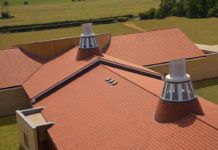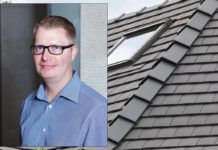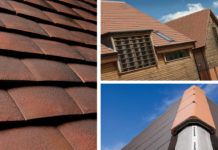

Some of the most common problems I come across in my role as technical manager of a roofing tile manufacturer are that of incorrect or inadequate roof specifications. This can, for example, mean that a roof may not perform properly in the long term in its primary functions of keeping out the weather and resisting high wind loads.
One of the problems facing the specifier and roofer is that there are products available that may or may not do exactly what the supplier says they will do. For example, currently, there are no British or European Standards for dry fix and roof ventilation products. This means there is no standard way of determining the amount of ventilation a product should provide, or for determining the wind load resistance of dry fix products, or even for the quality and durability of the material itself.
A new British Standard for dry fix roofing products is currently being written and is due for publication either later this year or early next year. This will provide test methods for ensuring that products are fit for purpose, as well as remaining durable in long-term use.
A common problem is that in an average pitch roof the components can be supplied from several different sources. The specifier or user then becomes liable for ensuring that all these products are fully compatible and the roof system performs correctly.
Traditional materials such as clay and concrete roof tiles and slates have a long history, so we know how long these products will last. Unfortunately, the same cannot always be said for other, but equally important roof components. Many products are supplied with guarantees and, of course, this is vitally important, but this does not necessarily ensure that a product is used in the correct way or is appropriate for the particular roof design.
Specification guarantee benefits
This is where the specification guarantee comes in. There are several available in the UK and one great example is our own Wienerberger Sandtoft RoofSpec system guarantee. Specification guarantees have become increasingly popular over the last few years because, not only do they ensure that the whole roof system is properly specified, but also that the roof will remain durable and maintenance-free for at least the period of the guarantee.
RoofSpec guarantees that the whole roof system is designed in compliance with BS 5534: Code of practice for slating and tiling, BS 8000-6: Workmanship on building sites and BS 5250: Code of Practice for the control of condensation in buildings.
The client supplies information about the project and then Wienerberger prepares a comprehensive specification, covering everything from the underlay, battens, tiles, fixing systems and accessories. It also includes the appropriate fixings to ensure the roof covering and all its components will resist the highest wind loads theoretically likely to occur once in 50 years. The specification is supplied to the client along with an individually signed guarantee certificate, assigned to the particular project.
The great thing about having a complete specification is that the client can be assured that all the components in the specification are fully compatible. All products specified are rigorously tested; from the tiles, dry fix systems, even the fixing clips and nails. RoofSpec ensures the specification is correct and the guarantee backs this, as well as covering all the individual components.
Wienerberger also offers an on-line Sandtoft RoofSpec service at www.roofspec.co.uk. This service is ideal for a client who wishes to produce a bespoke specification quickly. The software asks a few simple questions and then a comprehensive specification is produced. Anyone can use the service and, for registered users who log-on, the system will produce a bespoke RoofSpec guarantee certificate. The great thing about RoofSpec on-line is that it enables the user to generate specifications very simply, with safeguards to prevent inappropriate specifications. For example, it will only allow the specification of correct fittings, systems and accessories with each tile type, and it will prevent a tile from being specified at an unsuitable roof pitch etc.
There are other advantages to using RoofSpec. For example, by using all the components in the specification and installing them as specified, the client can be assured that the roof will remain maintenance-free for at least the period of the guarantee. This is very important for property owners, particular in the social housing sector, where certainty over maintenance costs is vital. Of course, it can be taken as read that the roof will actually last much longer than the RoofSpec guarantee period; the tiles are guaranteed for 30 years but have a life expectancy far in excess of that.
Summary
Take advantage of a specification and whole roof system guarantee wherever possible. This will ensure that all the components in the roof system are compatible, remain durable and comply with current Standards and good practice.



